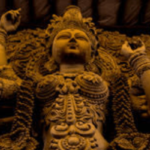Vṛitti-sārūpyam itaratra.
- Vṛtti – modifications, activity
- sārūpyam – assumes the form, identifies with
- itaratra – in other states
In other states, the Seer identifies with the modifications of the mind.
Most people perceive themselves as being solitary and inherently alone. Shaivism calls this individual experiencer the aṇu, a single dot of limited, subjective consciousness. Māyā śakti appears to divide our world into the subjective limited consciousness of the aṇu and the corresponding objective stuff out of which everything else is made, called prakṛti. The Sāṁkhya school and Tantric traditions of India view prakṛti in different ways. We will use the term prakṛti as described by Shaivism, a non-dual view in which everything that exists in the universe is seen as an expression of pure śakti, the divine energy of Consciousness. In Shaivism, when śakti contracts itself through māyā, it becomes prakṛti, a limited form of śakti that is the material/energy out of which our objective world is made.
Prakṛti is made up of three gunas, or qualities inherent in the natural world: sattva, rajas, and tamas. Sattva is the quality of purity, rajas of action and change, and tamas of inertia. Everything in the natural world manifests as an ever-changing combination of these three qualities, including our minds. In other words, we experience everything in our world as impermanent and in constant flux.
To understand the gunas, let’s consider the human body. An embryo inside the mother’s womb holds the ideal form of the human being in seed form, ready to grow and develop. This pure, ideal form of the human is the sattvic quality inherent in the embryo. It exists at every stage of the human’s development. When the embryo begins to grow and take the form of a baby, it displays its rajasic character, where dynamic movement and change are predominant. If during its development, the embryo is afflicted by a disease, which prohibits it from taking its ideal form, its tamasic characteristic becomes prevalent. Its pure form is concealed. The forms of the embryo, child, adolescent, adult, and aged person all contain the three gunas in mixed, continually changing proportions throughout each stage of life.
Because our objective world is composed of the gunas, nothing in it is solid or permanent. This corresponds to the First Noble Truth of Buddhism, that living in the world is unsatisfactory and creates suffering because nothing in it is fixed or something we cannot depend on. Everything continually changes and is impermanent.
The first expression of prakṛti and the gunas in the creation of our world is the principle of the mind, the filter through which the aṇu views the world. Seeing the world through our minds, the aṇu believes in and identifies with its thoughts. Our minds continually express the gunas. A sattvic mind reflects what it perceives with clarity and purity. A rajasic mind is dominated by desire for action and is continually striving. A tamasic mind is sluggish, dark and full of ignorance. In yoga, we strive to make our minds as sattvic as possible. The process of yoga has two goals: to regain awareness of our expanded Consciousness; and to withdraw from our identification with our thoughts.
Exercise
Sit in a comfortable meditation posture and begin the process of watching your breath rise and fall in a natural rhythm. As you inhale, feel it and descend deep into your lower abdomen, then pause. Now see it rise, as you exhale, and move toward the top of your head. Again, a slight pause. Continue breathing this way for several cycles, slowly inhaling and exhaling and watching/visualizing the breath rising and falling. Now watch as individual thoughts or emotions come into your mind. Focus on the first that arises and observe it. Then ask yourself, who is this “I” that is observing my thought or emotion? Is it an “I” that changes according to my mood or situation? Ask what is the essence of this “I”? Is it distinct from your thoughts or does it identify with them?








